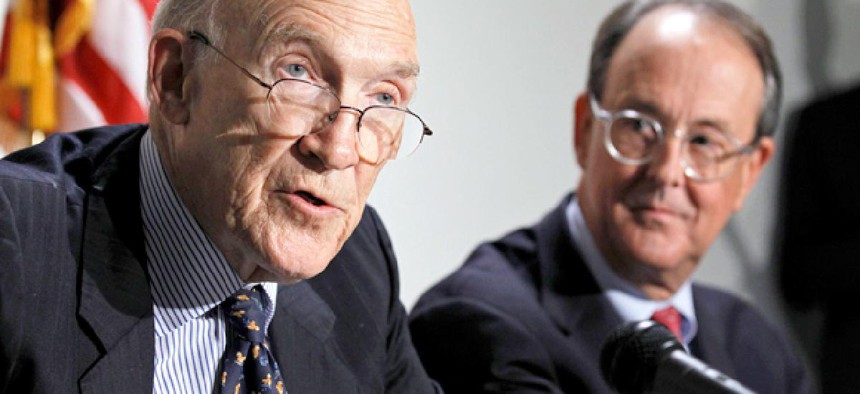
Erskine Bowles right, and former Wyoming Sen. Alan Simpson Alex Brandon/AP
Simpson and Bowles revive their plan in bid to avoid sequester
$2.4 trillion package includes changes to cost-of-living calculations for retirement programs.
This story has been updated.
The same day President Obama called for a new budget compromise, the two veterans of the most prominent fiscal commission sought to head off the scheduled March 1 across-the-board spending cuts by reviving a plan first offered in 2010.
Former Clinton White House Chief of Staff Erskine Bowles and retired Sen. Alan Simpson, R-Wyo., on Tuesday released a condensed version of their plan that would reduce the deficit by $2.4 trillion over 10 years, a number somewhere between the amounts sought by the White House and congressional Republicans.
At a breakfast sponsored by Politico Pro , the two lambasted the idea of allowing the long-dreaded sequester to kick in and expressed worry that the two political parties had “retreated to their talking points,” according to coverage by Politico.
The revised plan calls for cuts in Medicare and Medicaid of $600 billion as well as elimination of tax breaks to produce another $600 billion in revenue over 10 years. Yet another $1.2 trillion would be cut from discretionary spending and through changes in the cost-of-living calculations for major programs such as Social Security, agriculture subsidies and civilian and defense retirement programs.
“Although additional deficit reduction need not be enacted all at once in a single package, it should be enacted promptly,” Simpson and Bowles said in their statement. “The longer we wait the fewer options we will have and the less time we will be able to give individuals and businesses to prepare and adjust.”
Tax and spending reforms, they said, “should be designed to strengthen current economic conditions, promote work, encourage innovation, improve productivity, and bolster investment in our future.”
They called for bringing public debt as a proportion of gross domestic product from the current 73 percent to 70 percent by “early next decade.” Entitlement reforms “should either include protections for vulnerable populations or be coupled with changes designed to strengthen the safety net for those who rely on it the most,” they wrote.
The tax code should be reformed in a “progressive and pro-growth manner,” and entitlement programs should be altered to account for the aging of the population. Health care spending should be capped and linked to economic growth, they said. The “mindless” cuts of sequestration “should be replaced with targeted reforms that focus on the drivers of the debt while eliminating redundant, wasteful, ineffective, or unwarranted federal spending while preserving high-value investments,” the plan stated.
The debt limit should be indexed, they added, “to avoid the need for future political fights over raising it.”
The new plan drew praise from Maya MacGuineas, president of the Committee for a Responsible Federal Budget who had been working with Simpson and Bowles on the Campaign to Fix the Debt, saying the “approach has the potential to refocus the national discussion back where it should be - on how to actually fix our fiscal problems. Our political leaders seem alarmingly content to lurch from one near-crisis to the next and it is our hope that this new framework helps encourage policymakers to meet their fiduciary responsibilities and come up with a bipartisan plan to fix the debt.”
J. David Cox Sr., national president of the American Federation of Government Employees Union, was far more negative. He said in a statement that Simpson and Bowles “seem to have missed the fact that America had an election last November and that voters overwhelmingly rejected the regressive and idiotic ideas they were peddling on behalf of their corporate masters. We rejected more tax cuts for corporations and the wealthy. We rejected cuts in Social Security and Medicare benefits. We rejected taking away earned retirement benefits from public employees. We rejected an accelerated race to the bottom for the middle class and the working poor.” <p>
Cox added that it appears the two “will not stop until federal employees lose almost half of their retirement benefits, until hundreds of thousands of federal employees are thrown out of work, and millions of Americans either never retire or are poorer and more insecure in retirement because the Social Security and Medicare benefits which they paid for, and on which they hoped to rely, are slashed.” <p>
Obama, in a Tuesday morning press appearance, announced his willingness to work with Congress on a “balanced” approach to avoiding sequestration, adding that he had laid out “limited reform to our entitlement programs” along the lines proposed by Simpson-Bowles. “But no one,” he said, “should expect to get 100 percent of what they want.”
NEXT STORY: Play of the Day: Presidents on President's Day







